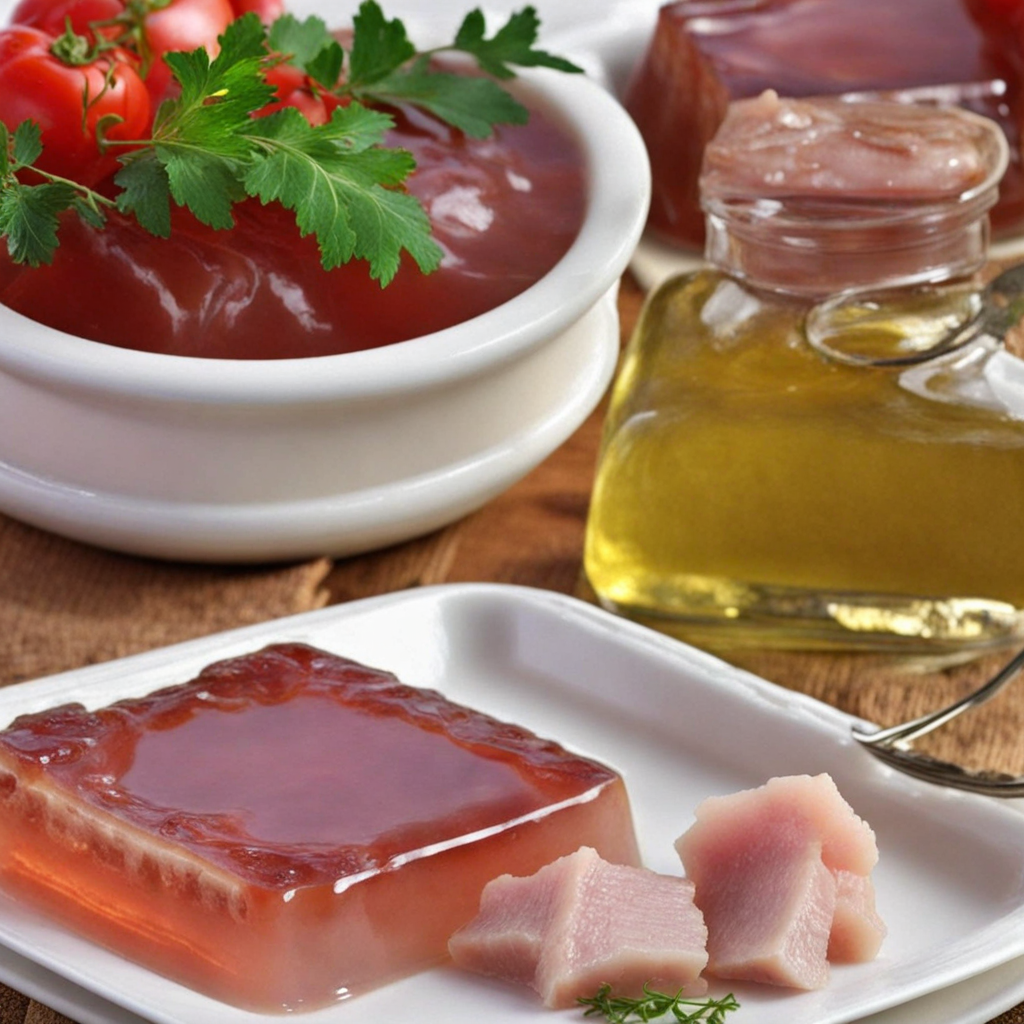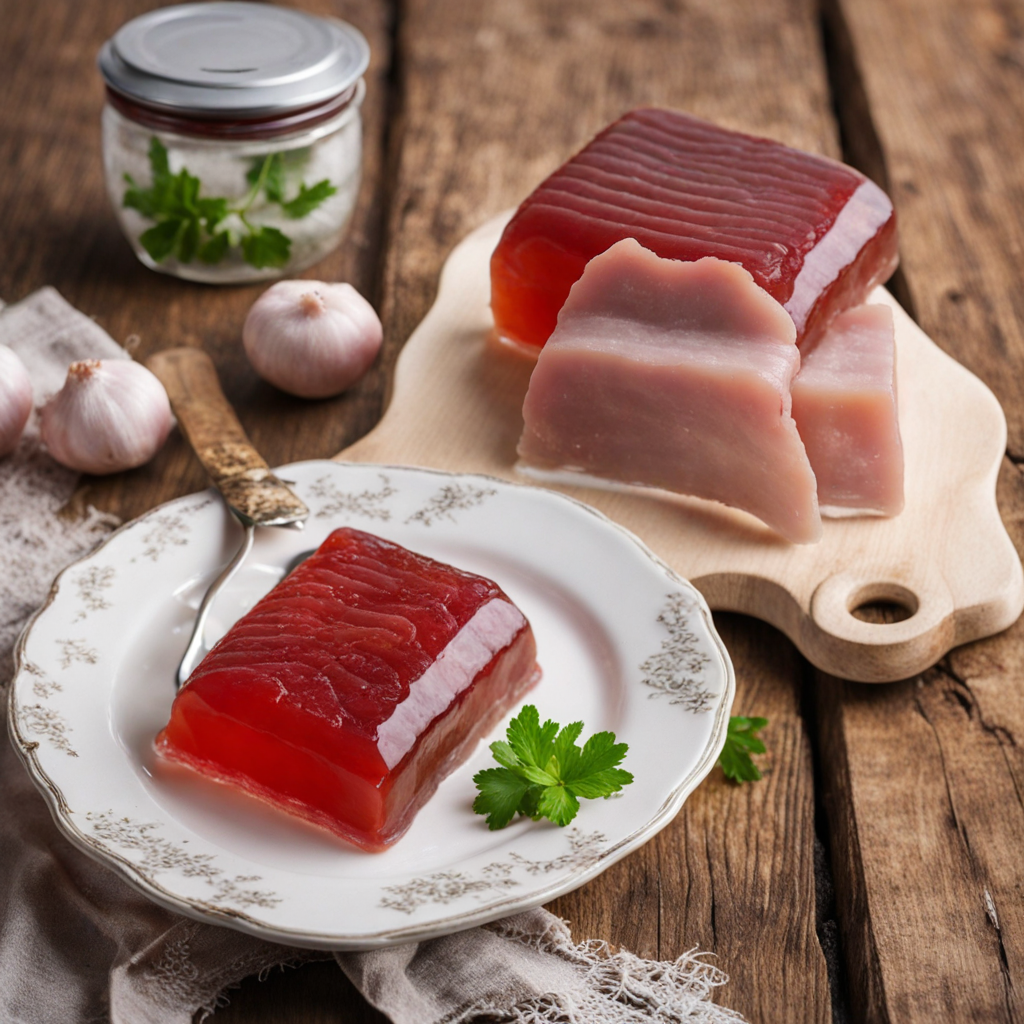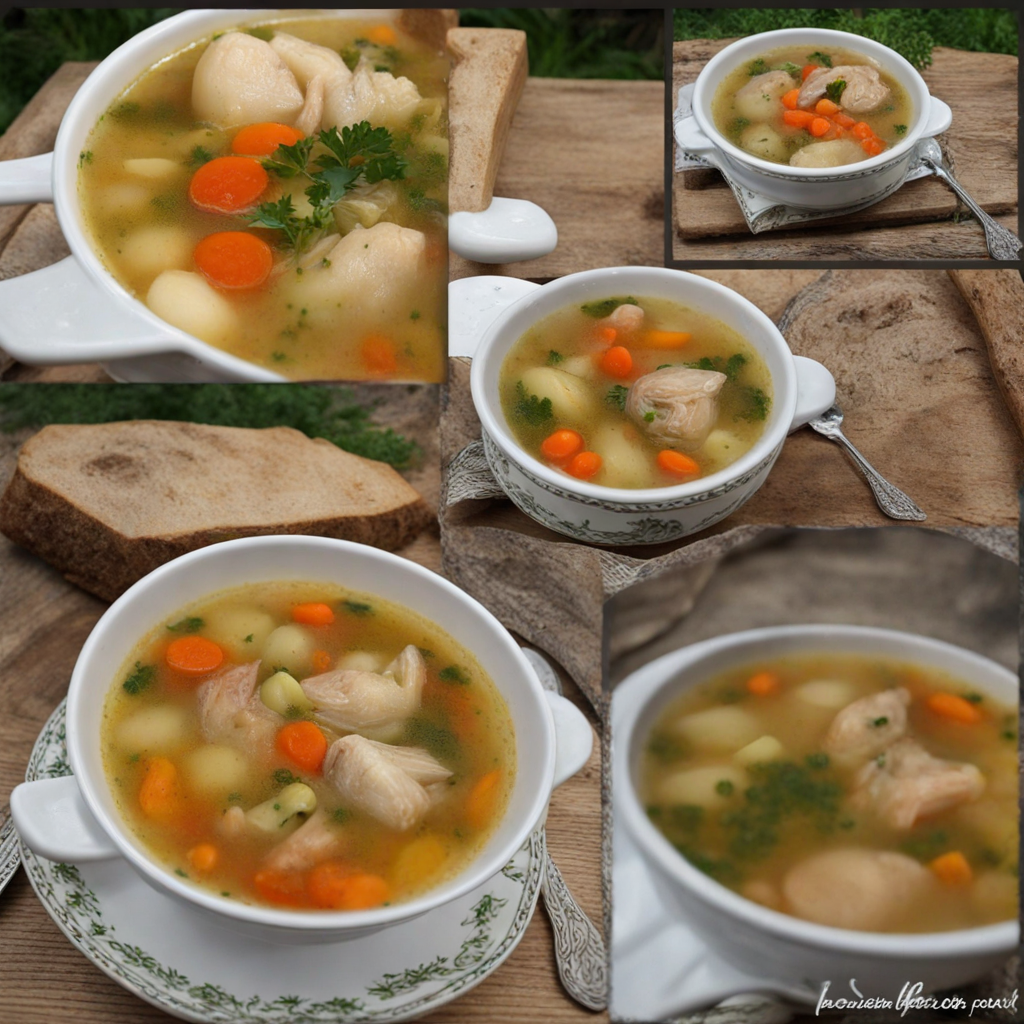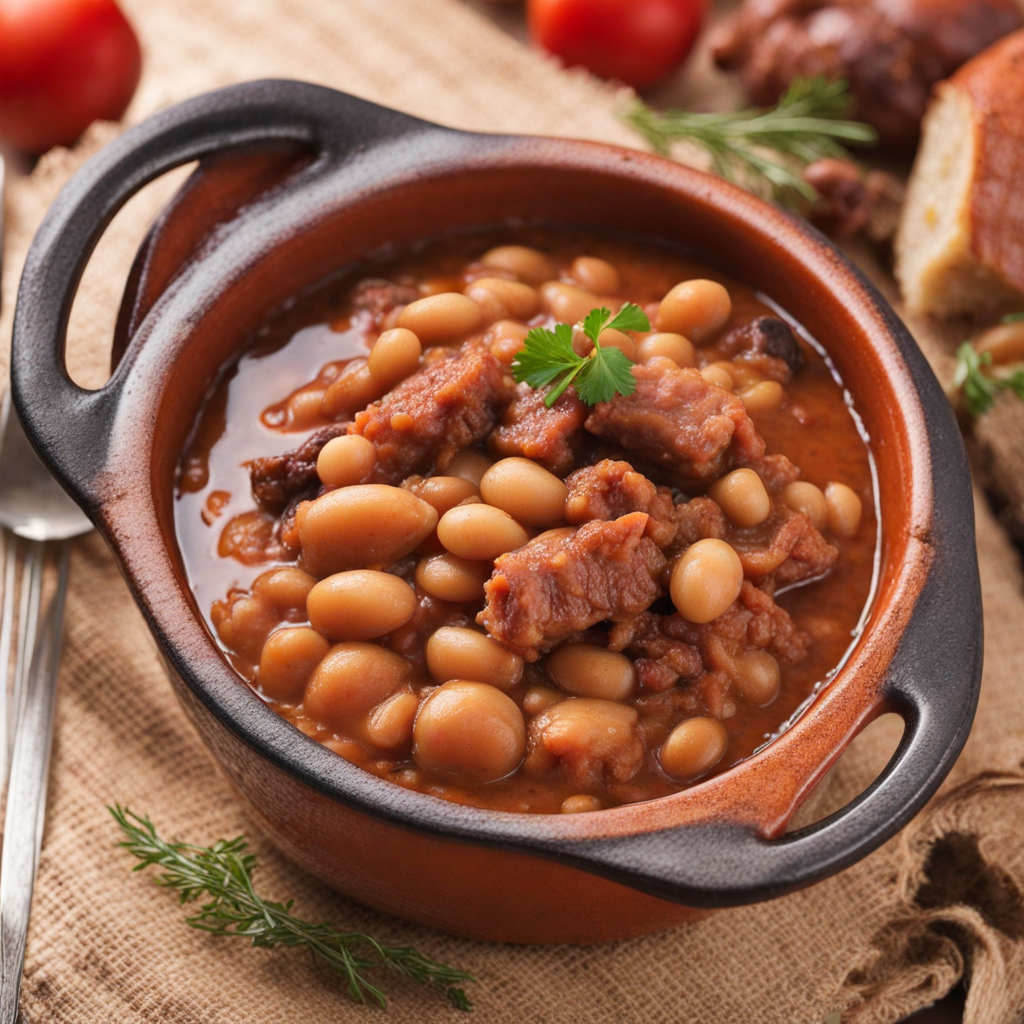Pork Jelly
Pork Jelly, known as "Răcitură" in Romania, is a traditional dish that showcases the country's rich culinary heritage. This unique delicacy is made by simmering pork bones and meat, often including trotters and other gelatinous cuts, for several hours until the collagen is released and transforms the broth into a thick, jelly-like consistency as it cools. The result is a visually appealing dish that presents itself in a clear, amber hue, dotted with tender pieces of meat and sometimes flavored with herbs, garlic, or spices. Served cold, it is typically sliced into cubes, revealing its wobbling texture, which can be quite an intriguing sight for those unaccustomed to it. The taste of Pork Jelly is a captivating blend of savory and slightly tangy flavors, enhanced by the natural sweetness of the pork and the aromatic notes from the added herbs and spices. Each bite offers a delightful contrast between the firm jelly and the tender meat, creating a pleasing mouthfeel. It's often accompanied by mustard or vinegar for an extra kick, which complements the richness of the jelly and provides a refreshing balance. The dish is particularly popular during festive occasions, where it is served as an appetizer or a cold starter, inviting guests to experience its unique texture and flavor profile. Pork Jelly is not just a dish; it is a representation of Romanian culture, where every family may have its own recipe and way of preparation, making it a cherished tradition. The crafting of this dish can be seen as an art form, often passed down through generations, and it embodies the spirit of communal meals where family and friends gather to enjoy homemade specialties. For those adventurous eaters seeking to explore new culinary landscapes, Pork Jelly offers a fascinating glimpse into Romanian gastronomy, inviting you to savor a taste of history and authenticity.
How It Became This Dish
Piftie: A Culinary Gem of Romanian Tradition Piftie, a traditional Romanian dish, is a culinary masterpiece that embodies the rich tapestry of Romanian culture and history. This dish, often referred to as “piftie de porc” or “piftie de pui,” is essentially a jellied meat dish, typically made from pork or chicken, and is celebrated for its unique texture and robust flavor. The roots of piftie are deeply intertwined with the agricultural practices and social customs of Romania, reflecting the country’s connection to its land and heritage. Origins of Piftie The origins of piftie can be traced back to rural Romania, where the practice of preserving meat through various cooking methods has been a tradition for centuries. In the past, the autumn pig slaughter, known as "tăierea porcului," was a significant event in Romanian villages. Families would gather to process the pig, using every part of the animal to minimize waste and ensure that nothing went to ruin. This communal activity not only provided sustenance for the winter months but also fostered a sense of community and shared heritage. Piftie itself is thought to have been influenced by various culinary practices from both the Ottoman Empire and the Austro-Hungarian Empire. The method of jelling meat using gelatinous broths is reminiscent of dishes found in many Eastern European and Balkan traditions. The use of spices, such as garlic and pepper, reflects the Ottoman influence on Romanian cuisine, while the concept of aspics and jellies can be traced back to the culinary habits of Central Europe. Cultural Significance Piftie holds a special place in Romanian culture, often served during festive occasions and family gatherings. It is particularly prevalent around the winter holidays, such as Christmas and New Year’s Eve, when families come together to celebrate and share traditional dishes. The preparation of piftie is not merely about the end product; it is an event that brings family members together, often involving multiple generations in the kitchen. The dish is also symbolic of abundance and hospitality. In Romanian culture, serving piftie to guests is a sign of respect and generosity. The dish's rich, savory flavor, coupled with its striking appearance, makes it a centerpiece at festive tables, reflecting the importance of food in social and familial bonds. The Making of Piftie The preparation of piftie is a meticulous process that showcases the culinary skills of Romanian cooks. Traditionally, piftie is made by simmering pig trotters, ears, and other gelatinous parts, such as the head, in water for several hours. This slow cooking allows the natural collagen in the meat to break down, creating a rich, gelatinous broth. After straining the broth to remove any solids, it is often flavored with garlic, vinegar, and black pepper, then poured over pieces of meat arranged in a mold. The mixture is allowed to cool and set, and once solidified, piftie is typically served cold, sliced into neat portions. It is often garnished with fresh herbs and accompanied by mustard or a vinegar-based dipping sauce. The dish’s transparent, jelly-like consistency and the tender meat pieces create an appealing visual contrast, making it a feast for the eyes as much as for the palate. Evolution Over Time Over the years, piftie has evolved, adapting to modern tastes and cooking techniques while still retaining its traditional roots. In contemporary Romanian households, the dish is sometimes made using store-bought gelatin to simplify the preparation process, though purists maintain that the best piftie is made from scratch, relying on natural ingredients. Moreover, piftie has found its place on restaurant menus across Romania, where chefs experiment with variations of the traditional recipe. Some may incorporate different types of meat, such as chicken or beef, or add vegetables for a modern twist. These adaptations honor the dish's heritage while catering to the evolving palates of new generations. In recent years, there has been a growing interest in traditional Romanian cuisine, both domestically and internationally. This resurgence has led to a renewed appreciation for dishes like piftie, as people seek to reconnect with their culinary heritage. Food festivals and cultural events often feature piftie as a highlight, showcasing its importance in Romanian gastronomy. Piftie in Modern Romania Today, piftie is not just a dish; it has become a symbol of Romanian culinary identity. The dish is often featured in cultural events, where chefs and home cooks alike showcase their skills and pride in traditional cooking. Furthermore, it serves as a reminder of the importance of communal meals and the values of sharing and togetherness that are deeply rooted in Romanian culture. Social media platforms have also played a role in promoting traditional dishes like piftie. Food bloggers and influencers share recipes, cooking tips, and personal stories related to piftie, helping to keep the tradition alive among younger generations. This digital revival has sparked interest in exploring the history and significance of piftie, encouraging people to try their hand at making it at home. Conclusion Piftie is more than just a jellied meat dish; it is a culinary symbol of Romanian heritage that encapsulates history, culture, and community. Its origins rooted in rural traditions, cultural significance during festive occasions, and evolution into a modern favorite, all contribute to its enduring popularity. As Romania continues to embrace its culinary heritage, piftie stands as a testament to the nation’s rich gastronomic landscape—a dish that not only nourishes the body but also feeds the soul, connecting generations through the shared experience of food.
You may like
Discover local flavors from Romania







